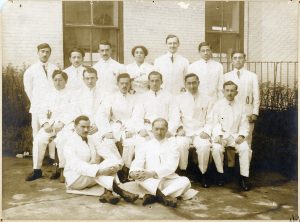The photograph above shows the house staff of the Beth Israel Hospital in 1913. By that year, Beth Israel had been active for 24 years, and since 1902 it had been located on Jefferson & Cherry Streets, where this photograph was taken. (The hospital moved to its current location on Stuyvesant Square in 1929.) Although Beth Israel was still a relatively young hospital, it was already a state-of-the-art medical facility, with modern operating rooms, a radiology department, and laboratories for pathology and physiological chemistry. The hospital had a house staff, the precursor of the modern residency system, on which recent medical school graduates would spend two years living at the hospital and acquiring clinical experience.
When the Aufses Archives first acquired this photograph, the identity of the woman standing in the back row was unknown. There were two prints of the photograph in the collection, and they were labeled with conflicting dates, neither of which seemed correct. One print was labeled 1929, but this could not be right, since the clothing appeared wrong for that date and the photograph was clearly taken at the Jefferson Street location. Another was labeled 1908, but in this case, who could the woman have been? The earliest known female doctor associated with Beth Israel was Nettie Shapiro, MD, who served a one-year term as a non-resident extern in 1909, but a comparison with other photographs of Dr. Shapiro showed that it wasn’t her.
The identity of the woman in the photograph remained a mystery until recently, when we discovered a newspaper article in a collection of clippings that provided the answer. The woman in the photograph is Sophie Rabinoff, MD, who was the first female member of the Beth Israel house staff. Born in Russia in 1889, the same year Beth Israel was founded, Dr. Rabinoff came to the United States as a baby with her immigrant parents. She grew up in New York City, where she attended Hunter College before receiving her MD degree from the Women’s Medical College of Philadelphia.
Like other female medical students of her time, in addition to the challenge of mastering the med school curriculum, Dr. Rabinoff had to overcome prejudice against women to continue pursuing a medical career. As the article describes, before taking the competitive examination for the Beth Israel house staff, she had to persuade the hospital management to allow her to sit for the exam. It was only after she came in first out of 31 candidates, ahead of 30 men who also took that year’s examination, that she was admitted. Unlike her predecessor Dr. Shapiro, who as an extern did not live in the hospital or serve the full two-year term, Dr. Rabinoff became a full member of the house staff, with all the accompanying responsibilities and privileges. Unfortunately, 1913 is one of the few years for which the Aufses Archives does not have the minutes of Beth Israel’s trustees or medical board, so we have no record of the debates that might have accompanied her admission.
The photograph in the newspaper article was clearly the same person as the woman in the photograph, confirming that this was an image of Dr. Rabinoff and the rest of the 1913 house staff. A search for additional information on Dr. Rabinoff revealed that she went on to a distinguished career in public health, as documented by her entry in the Jewish Women’s Archive Encyclopedia. After her time at Beth Israel, Dr. Rabinoff served with a Hadassah medical mission in Palestine before returning to New York and becoming a public health officer. She worked for two decades for the Department of Health, where she was responsible for overseeing public health programs in various parts of Manhattan and the Bronx, before joining the faculty of the New York Medical College in 1939. At her passing in 1957, she had recently retired as Director of the College’s Department of Public Health and Industrial Medicine.


